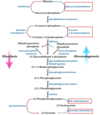MSK - Biochemistry - Glycolysis; Gluconeogenesis; Glycogen Metabolism Flashcards
(151 cards)
How many reactions occur in glycolysis?
What phase are the first 5 known as?
What phase are the second 5 known as?
10;
the investment/preparatory phase;
the payoff phase
What are the two goals of the investing/preparatory phase of glycolysis?
How many ATP are invested at this point?
- To make the process irreversible
- To split the 6-carbon sugar into two 3-carbon sugars
2
By the end of the glycolytic investing/preparatory phase, glucose has been split into two molecules known as:
Glyceraldehyde-3-phosphate
In the second five glycolytic reactions, the payoff phase, what high energy molecules are produced?
What is the net gain of glycolysis?
4 ATP, 2 NADH;
2 ATP, 2 NADH
Of the ten glycolytic reactions, which are the most important for a healthcare provider to know?
1, 3, 6, 7, (9), 10
The GLUT transporters work via what type of transport?
Facilitated diffusion
What GLUT transporters are found in virtually all mammalian tissues and maintain basal glucose levels?
GLUT1, GLUT3
What GLUT transporter is found in liver and pancreatic cells (as well as the basolateral portion of epithelium in the small intestine) and removes excess glucose from the blood / controls insulin secretion?
GLUT2
What GLUT transporter is found in muscle and fat cells and is insulin sensitive?
GLUT4
What GLUT transporter is found in mucosal membranes and spermatozoa for fructose transport?
GLUT5
GLUT1 and GLUT3 are found in what tissues?
What is their purpose?
Virtually all mammalian tissues - maintain cellular basal glucose needs
GLUT2 is found in what tissues?
What is its purpose?
Pancreatic tissues - control insulin secretion;
Liver and small intestinal tissues - removes excess glucose from blood
GLUT4 is found in what tissue(s)?
It is ________-sensitive.
Muscle and adipose;
insulin
GLUT5 transporters move what substance?
Fructose
For GLUT1, GLUT2, GLUT3, GLUT4, and GLUT5, state the relative Km for each.
(place them in order of increasing Km)
GLUT3 - 1 mM
GLUT1 - 1 - 2 mM
GLUT4 - 5 mM
GLUT5 - 10 mM
GLUT2 - 15 - 20 mM
Normal physiological glucose levels are around: ____mM.
5.5
(100 mg/dl)
Which GLUT transporters are transporting glucose almost all the time?
Which GLUT transporters are transporting glucose in the well-fed state only?
GLUT1, GLUT3, GLUT4;
GLUT2
(note: GLUT5 transports fructose)
Describe the basic steps of insulin secretion.
1. Glucose levels rise (GLUT2 Km = 15 - 20 mM)
2. GLUT2 transporters allow glucose into pancreatic β cells
3. ATP is formed via glycolysis
4. ATP turns off K+ leak channels
5. The cell depolarizes
6. Calcium floods the cell and insulin is released

What is the 3-carbon end product of glycolysis?
Pyruvate
How do anti-hyperglycemic drugs such as sulfonylureas or meglitinides work?
What drug does the opposite?
They close ATP-sensitive K+ channels in pancreatic β cells
(note: these are channels that were pumping K+ into the cell);
diazoxide (treats insulinoma-induced hypoglycemia)

Should type I diabetics be given sulfonylureas and/or meglitinides?
Should type II diabetics be given sulfonylureas and/or meglitinides?
They shouldn’t. They don’t have β cells;
Yes
Where are GLUT4 transporters when glucose levels are low?
Where are GLUT4 transporters when glucose levels are high?
Endocytosed;
on the plasma membrane (exocytosed)
What is the first step of glycolysis?
Why is this step important (3 reasons)?
Hexokinase adds a phosphate to glucose (making G6P).
- Energy investment
- Traps glucose in cell
- Ionic charges increase favorability of subsequent interactions

What are substrates and product of the first step of glycolysis/
Glucose (+ hexokinase + ATP + Mg2+) –> Glucose-6-phosphate






































